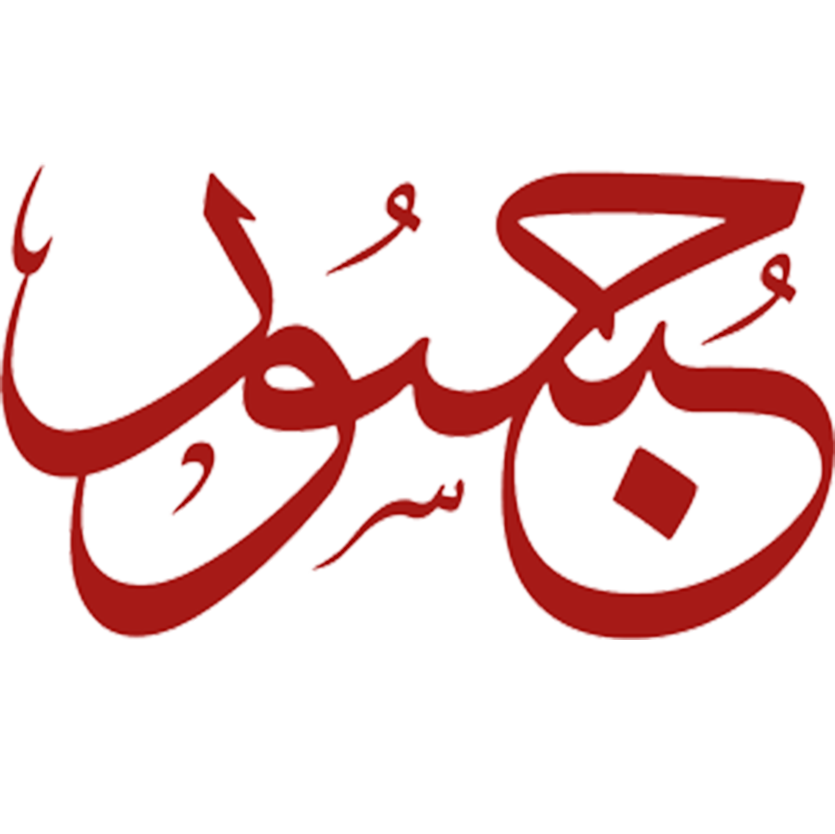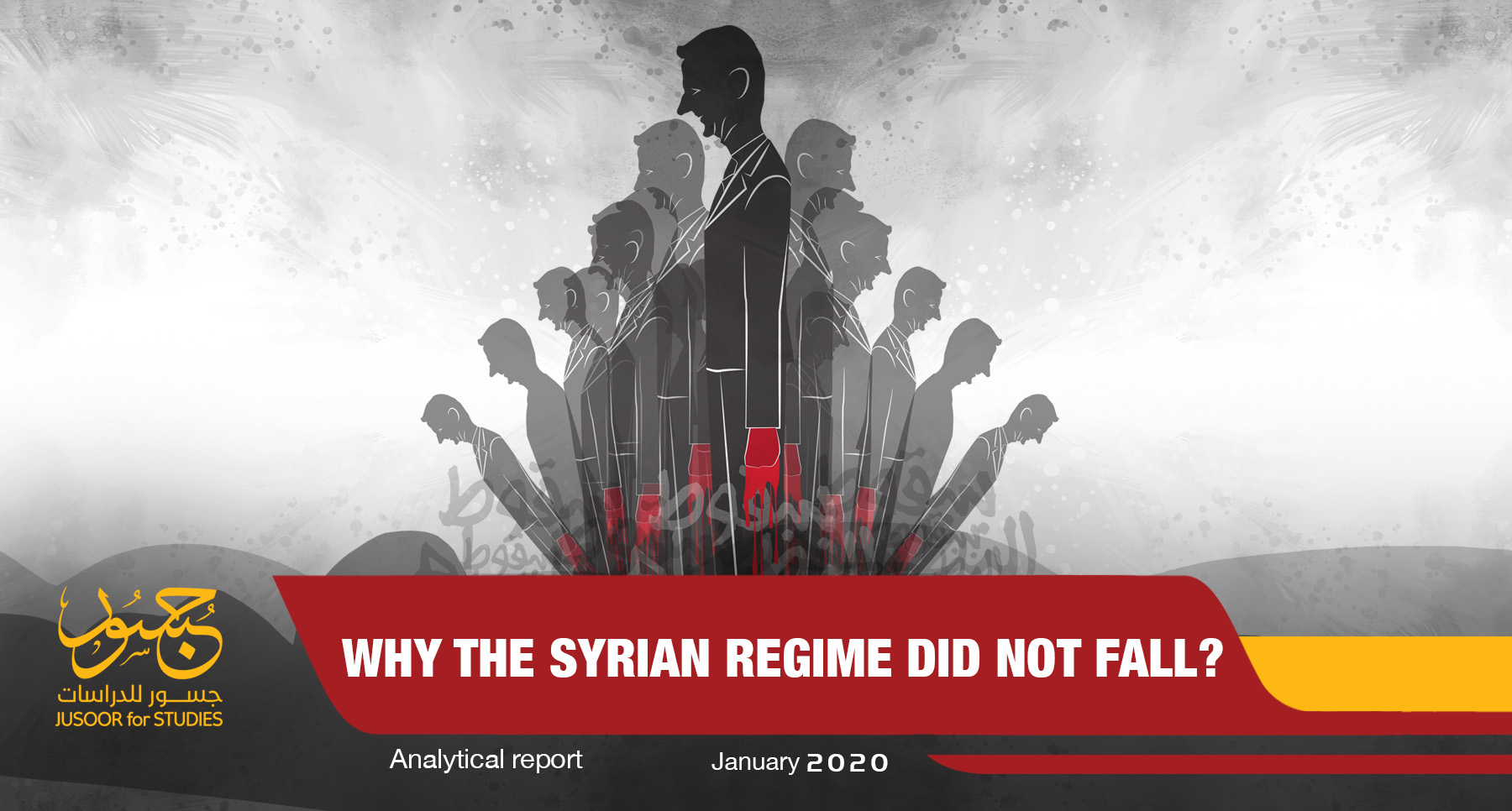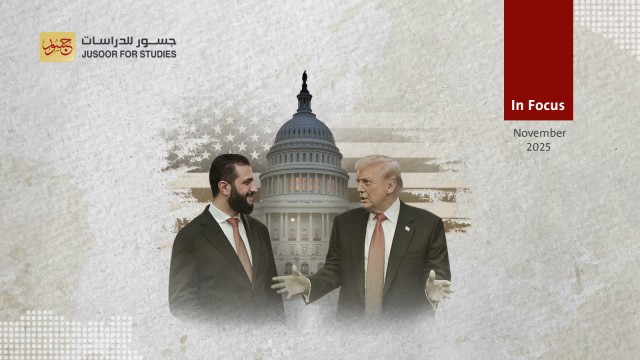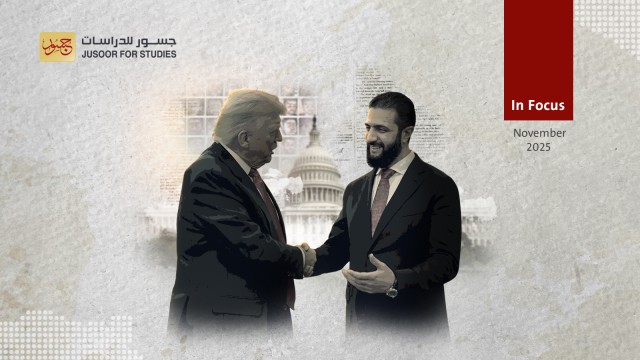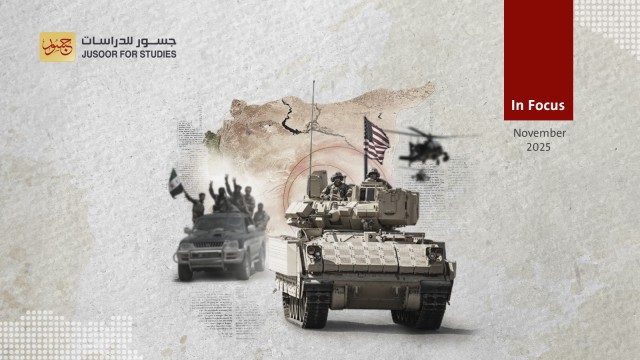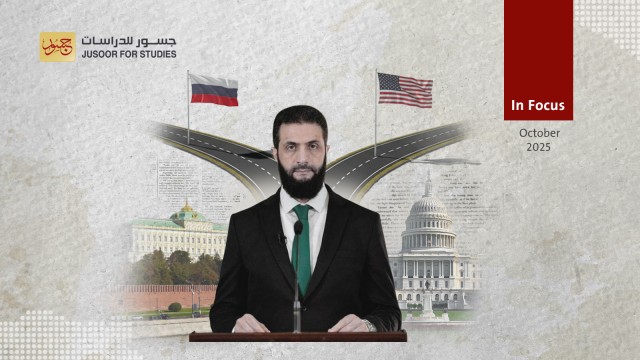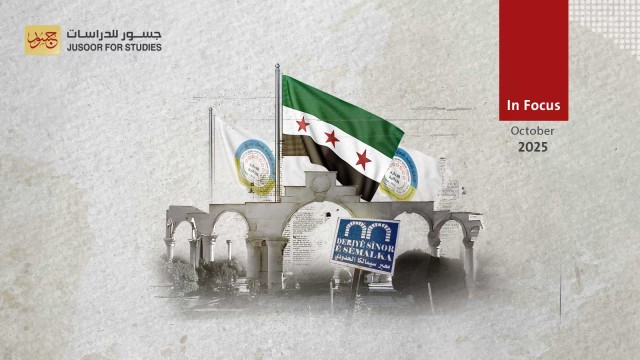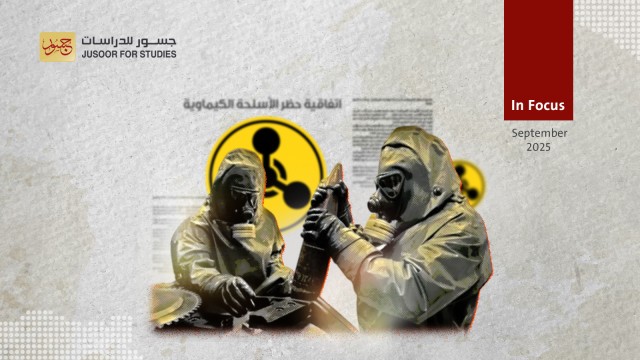Why the Syrian Regime did not Fall?
Font Size
Introduction
The popular protests that started in the spring of 2011 in Syria adopted the slogan of overthrowing the regime, an extension of the slogan that prevailed at the time in the different Arab Spring countries. Although some protesters initially chose to limit their demands to reform and change, the call to “overthrow the regime” quickly overtook all other demands.
Syrian local forces and regional and international actors had mixed responses to the call to overthrow the regime. These demonstrated through the lack of coherent vision and fixed positions, or later the desire and ability to respond especially after this demand became linked to the security and stability policies of the region.
With the conflict in Syria entering its first decade, the regime still holds the reins of government, despite the fact that its governance is fragile, and its control is limited to less than two-thirds of the country. It is evident that no international actor wishes to overthrow the regime; however, this does not mean these parties want the current form of the regime or the pre-2011 form to remain in power.
The peaceful movement that began in 2011, and later turned into an armed conflict has posed the greatest challenge to the regime’s survival since the Hafez al-Assad came to power in 1971. This is not disregarding the various other challenges the regime faced over the years including the conflict with the Muslim Brotherhood and the subsequent militant vanguard between 1978 and 1982, the economic sanctions imposed between 1979 and 2010, the transfer of power to Bashar al-Assad in 2000, and the Special Tribunal for Lebanon to investigate the assassination of the former Prime Minister Rafik Hariri in 2005 among other challenges.
For four decades, the Syrian regime derived its power and ability to maintain power from its complete control of the military and security establishment, building a totalitarian state, eliminating oppositional forces, deepening its strategic alliance with Iran and Russia and its understanding of the United States and Israel’s security and stabilizing policies in the region among other domestic and international factors.
However, at the end of the fifth decade of regime control over Syria, the previously mentioned factors appear to have been severely disrupted in terms of the regime’s ability to independently and, relatively, effectively pursue policies that guarantee continuity and survival. This imbalance may be an extension of the faltering policies that al-Assad adopted in the fourth decade of the regime’s reign that did not reflect a coherent structure and vision for the future of the regime’s relationship with local, regional and international actors.
This report aims to formulate an understanding of the subjective and objective reasons for the Syrian regime withstanding the revolution, whether it is an evidence of the regime’s success or the opposition’s failure and whether the regime not falling means the regime still in power or
that it will develop a different form other than the pre-2011 version.
First: Why did the regime not fall?
Regime supporters, Syrians and non-Syrians alike, try to portray the regime not falling as a reflection of the regime’s internal strength, and in some cases also mention its affiliation with the so called “axis of prevention and resistance”. In addition to trying to portray the regime not collapsing as a victory. In contrast, regime opponents amplify the external causes that enable the regime to continue standing to downplay any internal causes inherent to the regime or the opposition.
It is possible to objectively list the reasons that led to the regime’s failure according to the following conception:
1) Internal Reasons
Since 2011, many countries expected or hoped that the Syrian regime would collapse within a short period(1), and the regime, in turn, used these “expectations” as an opportunity to assert its control(2).
The Syrian regime relied on four internal factors that prevented its downfall: legitimacy, strength, wealth and protection.
A. Local Legitimacy
Legitimacy can be divided into two types, the first is local, and is based on the regime’s ability to control society and provide services, while the second refers to international legitimacy, based on the international community’s recognition of the regime as a representative of the state, and recognition of the documents the regime issues.
Historically, the Syrian regime has used excessive violence, monopolized decision making and security to perpetuate its legitimacy domestically due to its lack of legal legitimacy, given it is a coup system that became a hereditary succession system.
The regime has worked to establish its local legitimacy by maintaining the functioning of state institutions, providing public services, continuing to pay employee wages even in areas outside its control(3), and its insistence on activating government directorates as a key condition in the settlement and reconciliation processes witnessed between 2012 and 2018. Implementing these measures during the temporary ceasefire agreements was aimed at creating a feeling that state institutions are the basis for the stabilization and security among the local population(4).
The regime also monopolized the provision of public services for citizens they were unable - even in their displacement and forced migration- to locate suitable alternatives to help them overcome the challenge of instability. Citizens continued to rely on the regime to issue their documents including the most basic, such as a civil registration to obtaining a passport or registering a birth certificate among other official documents.
The regime has benefited from the international recognition of its documents to blackmail opponents and obtain a surplus of legal and political power as well as economic returns(5).
B. Power
Since its establishment, the al-Assad regime has relied on the military and security institutions, which Hafez al-Assad exercised considerable efforts to form and indoctrinate based on a sectarian component in the 1980s, to maintain internal and regional rule and stability. Bashar al-Assad continued this approach and even strengthened by dedicating massive efforts to achieving this after 2011.
The military and security forces that the Syrian regime used to confront the peaceful and armed conflict were greatly exhausted, entire units went out of service, and the conflict revealed the absence of the required field competence which resulted in regime allies’ direct intervention; However, the coherence of the security and military infrastructure has undoubtedly helped prevent the fall of the regime.
The Syrian regime exercised great efforts to maintain the balance of the security services and the army to maintain control over them. It repeatedly rejected any solution or peace agreement stipulating the dismantling of these two institutions while requiring the dismantling of the armed factions and the reintegrate their members into the military establishment based on the mandatory military service law and its amendments following the signing of settlement and reconciliation agreements. The regime was relatively able to subordinate the leadership of military units created by Russia based on sectarian loyalty.
C. Wealth
Since losing control over the oil fields in the east of the country in 2012, the Syrian regime’s wealth has become based on revenues from the war economy represented by the following(6):
• State resources: Many laws were issued to activate the subjugation of state resources, for example law no.14 of 2016 according to which, the end of employment of state employees who join the reserve or mandatory military services is no longer activated and the employee’s salary continues to be paid from the institution he works in while he is in the army.
• Reliance on Patronage Network: This network played a prominent role in the operations to finance the war and support the Syrian Lira. For example, Rami Makhlouf's “al-Bustan Association” and his other companies, supported the National Defense militia and provided care for National Defense militia members’ families for years (this information was confirmed by Makhlouf in a recording posted on his Facebook page on 03/05/2020); the “Fawz Holding Group”, which belongs to Samer Fawz, contributed to financing the Military Security Shield forces and other groups; and the “al-Mouhymin Transportation Company”, also belonging to Fawz provided significant transportation and logistical supply support for the Syrian regime’s soldiers.
Later, in mid-2019, the Syrian regime made additional efforts to collect more money from the patronage network beyond the existing voluntary and legal support modes to maintain the greatest possible temporary stability in the exchange rate of the lira. The regime resorted to forcing network members to buy government bonds or at least treasury bills under the Securities Law of 2007.
• External borrowing: Due to the shortage of state public treasury resources and consequently the collapse of the foreign exchange reserves, the Syrian regime has resorted to taking out external loans. Deals have been concluded with Iran for multiple loans, most notably the Iranian credit line in 2013, whereby the external public debt reached 7.6 billion US Dollars in 2017. There are also debts owed to Russia and China.
• Armed Pillaging: The regime relied on armed robberies to finance military and paramilitary security forces, including kidnapping, prisoner swaps, taxation at checkpoints, blackmailing the families of detainees, and looting furniture and houses in villages and cities entered by the military forces.
• Fees and Taxes: Including revenues from issuing passports and other official documents which constitute an important source of foreign currency revenue from Syrians at home and abroad.
• Long-term Leasing of State Assets: This model has been used with Russia in particular, as Moscow wants to guarantee its long-term interests, even after a political solution is reached and the reconstruction process initiated.
D. Local protection
It is a group of networks founded or controlled by the Syrian regime since coming into power in the 1970s, and which is premised on sectarian, familial and political ties. The most prominent networks are:
• Sectarian Protection Network: The regime intentionally created fear and suspicion among members of the Alawite sect to ensure that the largest possible part of the sect continues to support it as well as making the regime’s survival the sect’s sole guarantee. The regime has benefited from the network of Alawite influence within state institutions, especially the army and security forces which is an influence established by Hafez al-Assad over the years, and later supported by Bashar al-Assad.
• The Family Protection Network: Hafez al-Assad increased his control over the regime by expanding the role of al-Assad family and their relatives, and then their clan. This network has expanded in recent decades to include the new members of the family and the children of officials.
• The Political Protection Network: It is mainly based on the Baath Party as the basis of rule since the establishment of the Syrian regime headed by Hafez al-Assad, relied on to justify the state control over individuals and society. However, after 2011, the party underwent fundamental changes due to the dissention of members, measures to replace the civilian leadership with military and security leaders, decreasing membership in rural areas and the like(7). In addition, the regime abolished country leader and secretariat and replaced them centralized and public leadership.
2) Reasons related to the International Community
Since the beginning of the conflict in 2011, objective reasons have helped the Syrian regime maintain power and continue to confront the political and armed opposition and social forces rejecting it. Bashar al-Assad’s speeches often reflected an exaggerated confidence in his ability to survive compared to the circumstances surrounding him. However, the Syrian opposition forces’ performance as well as the positions of the international powers have always increased that confidence and led al-Assad to hold onto his desire and his pursuit of survival and remaining in power.
A. The Performance of International Powers
International powers played a major role in the Syrian regime not falling, and subsequently, in strengthening its presence by expanding its scope of influence and control at the expense of other local actors, as well as the regime’s position in the political process.
• Lack of Seriousness: Most of the international powers were focusing their efforts jointly or separately on different priorities than overthrowing the Syrian regime. The priorities varied from maintaining stability, fighting terrorism and other issues that affect regional and international peace and security. This is evident in all the international settlement initiatives reached since the release of the Geneva Statement I of 2012, the Vienna decisions and other UN resolutions such as 2118 (2013) and 2254 (2015), and bilateral memoranda of understanding such as Sochi (2018) and (2019), and Moscow (2020) among others.
• Lack of Accountability: All the UN Security Council resolutions on Syria have avoided specifying responsibility for the violations while merely describing them as crimes, due to Russia using its veto right 14 times between 2011 and 2019, with support from China. In addition to the lack of effective mechanisms outside the UN institution that can be used to hold the Syrian regime accountable, with the exception of the introduction of The Fact-Finding Mission of the Organisation for the Prohibition of Chemical Weapons (OPCW) in mid-2018.
• Individual initiatives were also linked to the priorities of regional peace and security with a clear aim to not jeopardize the stability of the Syrian regime. On this basis, the three-way lightning attack on certain Syrian regime locations in August 2018 by France, Britain, and the United States came after the regime used chemical weapons.
• Absence of Will: The active forces in the region and the world did not seem to have a serious desire to overthrow the regime, but rather worked to intervene at the appropriate moments to prevent the fall of the regime. On different occasions, the United States of America and Israel have expressed desire for the regime to change its behavior, but not to topple it. Moreover, these countries made no efforts to curb the regime’s political legitimacy, such as restricting the regime’s presence in international organizations or targeting the regime’s legal legitimacy by accepting official documents issued by another representative body.
• Different International Visions: Despite the absence of a general desire to topple the regime, the international community also lacked a general agreement about the desired form the regime should take or the type of opposition that it wanted to support. The Friends of Syria Group, established in 2012, reflected these varying desires. It was also reflected within the command and coordination operations rooms in Ankara and Amman, which were established in 2013 and 2014 respectively, to provide military support to the opposition factions. This resulted in international actors investing in their own projects in Syria, at the expense of collaboration work, even at its minimum, which gave the regime and its supporters an opportunity to live and continue.
3) Reasons related to the Opposition
The Syrian political and military opposition forces’ performances often contributed to enhancing the Syrian regime’s ability to withstand the opposition rather than push it towards falling as the following points clarify:
• The Rapid Transition to Military Action: This allowed the regime to shift the conflict to the military and security field where it excels, rendering the opposition military factions at the mercy of international supporters given the high costs necessary for these factions to operate other than the costs of carrying out effective battles. All factions which could not seize resources to become self-sustained became tools controlled by external actors.
• The Emergence of Rivalry and Opposing Projects: The opposition was divided politically and militarily according to different projects; some took the form of acute religious extremism. The rise of the Islamic State in Iraq and Syria (ISIS) contributed to raising the level of religious discourse among the factions in an attempt to stop ISIS from influencing their audiences and even their fighters.
• Competition for Status and Resources: At the political, military or civil level, this factor did not only contribute to preventing the formation of a common front, but also further limited local ideological identities and downplayed political projects at the expense of the primary goal of overthrowing the Syrian regime.
It is noted that almost all the factions, after several years of fighting, no longer want to fight battles outside their areas, nor to start battles that do not serve their direct interests.
• The Absence of Independent Policies: This factor originally resulted due to the combination of the aforementioned reasons, but in itself, it led to a shift from the idea of overthrowing the Syrian regime to responding to regional and international security policies. The opposition’s goal then became to establish contact lines, cease-fires, and the establishment of a safe zone.
• The Absence of a Clear Vision: Concerning the form of the state and government for the future of Syria, or even a precise definition of the concept of “overthrowing the regime” that prevailed in the slogans of the early years of the protests. Popular support set a ceiling for the slogan whereby it could not be anything less than “toppling the regime with all its symbols and pillars”; although, over time, most opposition actors realized that this was unrealistic or no longer viable.
• Weak Performance: Weakness at the organizational and leadership level among the armed opposition factions, which led to a growing influence and presence of extremist organizations. It is a factor that has strengthened the Syrian regime and its allies’ ability to use the presence of these organizations to enter international settlement and ceasefire initiatives on the pretext of fighting terrorism as is the case in all agreements from Geneva to Astana.
The political and military opposition demonstrated clear weakness in its performance, as unqualified individuals assumed leadership positions in most of the military factions, and civil and political bodies. The local governments established in areas outside regime control presented irrational models of governance which served the regime’s project and limited the public’s desire to rally around the slogan of overthrowing the regime.
• The Absence of Self-Initiative: in political representation and then solutions as most of the opposition bodies were formed by non-Syrian initiatives which made them vulnerable to international and regional polarization. It is a loophole that the Syrian regime and its allies have long benefited from, by constantly questioning the cohesion of the opposition and its representative capacity.
Second: Actors’ Positions on the Overthrow of the Syrian Regime
1) The United States of America
The US did not seek to overthrow the Syrian regime militarily before 2011, despite its policies to destabilize the region before 2011 including its policies in Iraq that led to the death of US soldiers.
After 2011, Washington debated the idea of toppling the regime at various stages in a way that would not affect its policies and priorities in the region which are based on protecting Israeli national security, ensuring regional security, undermining and containing Iran’s activities and combating terrorism(8).
However, the regime greatly benefited from the existence of a Democratic administration that was previously awarded the Nobel Peace Prize. The White House rejected the recommendations presented to it from parties within the administration, or from friendly countries, if these recommendations would contribute to the fall of the regime or to a military action against it.
President Obama’s statements about the need for the al-Assad regime to fall did not amount to an announcement of an American plan to overthrow the regime, as much as it was an attempt by Obama to establish a position before al-Assad’s, anticipated, impending fall from power. The move aimed at positioning America on the “right side of history” and prompted other Western politicians to do the same(9).
Therefore, all American statements regarding democratization and empowering peoples to self-determination were theoretical trends, and they did not turn into a viable practical project.
Later, Washington stopped discussing plans to topple the regime, and adapted its approach to demanding the regime changes behavior(10) or fighting terrorism, which came into being as a result of the regime’s behavior. Washington used several tools, the most important of which was to tighten the scope of economic sanctions against the regime culminating in the adoption of the Caesar Law to protect Syrian civilians at the end of 2019.
The prior information confirms that the American position was and still is “regime change”, not overthrowing the regime.
2) The European Union
The European Union (EU) position since the beginning of the conflict in Syria was decisive by calling on the regime to respond to protestors’ demands and, later, for al-Assad to leave power. Despite certain EU member states having good relations with the Syrian regime, the EU position stems from the regime’s failure to show economic and investment flexibility or the appropriate openness to allow EU countries or its members to play an active role in the countries of the Middle East prior to 2011(11).
The EU did not adopt the call for the overthrow of the regime, but some EU member states especially France, participated in these calls and inciting Washington towards them at certain stages.
In general, the EU is consistent in its policy towards Syria with the American tendencies, as it participates in imposing economic sanctions on the regime and in linking the reconstruction process to the adoption of a political solution. The EU has also exerted political pressure on the regime and its allies in international forums, thus strengthening the “behavior modification strategy or making changes to the regime structure” and not overthrow it.
3) Russia
Since 2011, Russia has stood against the efforts to overthrow the Syrian regime and used military force, conditional economic support, and its diplomatic influence, especially its Security Council veto power 14 times to prevent the condemnation of the regime or any form of threat to destabilize the regime rule.
Russia’s military intervention at the end of September 2015 was one of the main external factors that prevented the fall of the regime. According to the Russian Foreign Minister, the regime’s collapse was estimated to occur three weeks after the Russian intervention(12).
Since its arrival in Syria, Russia has worked to strengthen regime structures by increasing the centralization of institutions, and trying to end the formation of militia, among other efforts. Russia has worked to bring about changes in the structure of the army by creating new brigades - such as the Fifth Division - and supervising them. However, these efforts did not achieve much change in the regime structure especially with the presence of opposing Iranian influence.
On the other hand, Russia has overlooked all strikes carried out by international and regional powers against the interests of the Syrian regime, as long as these attacks did not pose a threat to the structure of the regime. This applies to most of the strikes carried out by Israel since 2013. However, Russia did use diplomacy to stop some of strikes and operations, as was the case in August 2013, when it presented the Obama administration with an offer to hand over chemical weapons in exchange for stopping the US strike.
Moscow believes that the idea of “overthrowing the regime” is Western desire to impose its agendas and subjugate countries to their power. Hence, if such a scenario- Russia calls it the “incitement of peoples against their symbols and political systems” -was to take place in Syria, it might occur in Russia which constitutes part of the Russia obsession against any Western move in this regard.
4) Iran
Since 2011, Iran has faced efforts to overthrow the Syrian regime, and has used military force through its proxies in the region, as well as conditional economic support, to prevent this occurrence. Despite the great international pressure exerted on Iran to limit its influence and support for the Syrian regime, Iran’s position has not changed.
On the other hand, Iran does not want the regime to return to its pre-2011 form, as it has worked regularly since 2011 to weaken the regime and render it a weak entity thereby enabling Iran to control the state and society. This would allow Iran’s leaders and other followers, especially Hezbollah, to play a role in controlling the regime rather than working under its auspicious as was the case prior to 2011.
Iran is showing a special interest in strengthening its religious and societal influence which is reflected in its forces participating in religious activities and societal alliances. Tehran believes that altering beliefs gives it a firm foothold in Syria, and will complicate its future expulsions from Syria.
5) Turkey
Turkey agreed with the demands of reforming the Syrian regime in 2011, but it later changed its stance to calling for its overthrow. This shift can be attributed to Ankara’s anxiety about the extent to which the regime can be relied upon to provide stability in the region, which is the basis of Turkish foreign policy(13).
Turkey then resorted to securing its southern borders with Syria through international peace initiatives in cooperation with Russia, Iran, the US and the EU, and later using direct military force. This change in priorities contributed to Turkey partially abandoning the demand to overthrow the Syrian regime, but this did not lead it to accept its allies’ efforts to re-normalize relations with the regime. It has also found itself in direct confrontation with the regime after the regime continued to challenge Turkey’s ability to protect its soldiers and its presence in the northwest of Syria, by announcing the Spring Shield operation in February 2020.
However, Ankara continues to maintain the idea of overthrowing the regime despite all the difficulties and challenges facing this endeavor. Turkey’s goals in Syria include ensuring that the regime in Damascus is reconciled with Ankara and achieves future alliances that will preserve Ankara’s security and economic interests which can only be achieved by overthrowing the regime or contributing to the regime’s fall.
6) Israel
Since 2011, Israel has not shown any consistency between its official discourse and military behavior regarding the overthrow of the Syrian regime. The Israeli political and military position demonstrates that it never wanted to overthrow the regime despite its ability to do so. Israel prefers to deal with the regime it knew and tested for decades as the regime has acted as a safe barrier for Israel, rather than engaging with an untested alternative.
On the other hand, Israel has adopted a policy of direct intervention to limit the regime’s capabilities by targeting its Iranian ally. This intervention was reflected in its airstrikes since 2013.
Third: The Fate of the Regime
Since the beginning of the conflict in Syria in 2011 until 2020, the structure of the Syrian regime has undergone significant changes affecting many military, security, economic, political, and social sectors.
Politically, the regime has lost its external political presence and become a pariah in regional and international forums. It does not seem possible for the regime to return to its normal state before adopting a political solution acceptable to the international community.
The regime lost much of its influence on the Syrian decision, after having fully controlled it prior to 2011. The regime’s decision has become contingent on the approval of its allies. The regime has turned to working in the small margins that are available to it, similar to the remaining Syrian components including the opposition and the Kurdish forces.
Although the opposition failed to obtain international legal legitimacy, it managed to elicit political recognition of its existence as a counter to the regime. This recognition is demonstrated in the regime’s allies adopting the Constitutional Committee, and prior to that in their approval of the Geneva and Astana frameworks.
Militarily, the army has become weaker and more vulnerable than ever before. The army has lost most of its tanks, armored vehicles, aircraft and air defense systems, and it is not believed that it will be possible to recover these capabilities in a short time(14).
The army has also lost much of its capabilities in recent years, and its components have become a mixture of regular and militia forces, with loyalty and influence distributed among the Iranians and Russians. This is in contrast to the pre-2011 situation where the regime held absolute loyalty and influence.
Thus, the army, which represents one of the regime’s arms, is no longer as influential as it was before, and any attempt to reconfigure it will be subject to external forces that will further reduce the regime’s role and influence.
Economically, industry has ceased completely or almost completely in many major productive sectors, and the regime has lost control over many vital resources, especially oil and gas, and much of the agricultural land east of the Euphrates and in northern Syria.
The war years resulted in the exhaustion of the public budget, the weakening of foreign exchange reserves, and the accumulation of external debt.
The regime’s military and security operations also caused the transfer of much Syrian capital abroad as well as emigration of thousands of qualified and competent Syrians.
The value of the Syrian pound recently decreased significantly until it reached levels that it did not reach throughout the war. Current indicators show that the pound’s value will continue to decline in the foreseeable level.
All these indicators demonstrate that the regime has witnessed a state of economic collapse at the level of the state.
Socially, the Syrian regime has lost many of the protection networks that it had established over the past five decades, forcing it to rebuild new social and security networks in areas outside its control which subsequently regained. The popular protests acted as a watershed moment between two eras of rule and power. This came at the expense of these areas becoming security hotspots that pose major challenges to the regime’s ability to control them as is the case in southern Syria.
The previous changes to the structure and shape of the Syrian regime, due to the years of conflict, constitute a suitable ground for envisioning the future of the regime according to the policies of international powers.
1) Russia
Russia seeks to reform the Syrian army and render it professional and non-ideological, and unable and unwilling to threaten neighboring countries .
The Syrian regime is reluctant to take any steps that would undermine its control over the military or security institutions, and this explains the unprecedented increase in appointments based on sect. It does not seem that the regime’s reluctance will be feasible in the future.
As long as Israel intends to weaken the state in Syria, a goal that it often seeks in a way that does not contradict Russia’s policies concerning the Syrian state, it is therefore possible for the two to reach bilateral understandings that would reduce the size of the armament, training and strength of the Syrian military in the future.
However, Russia’s insistence to uphold the Syrian regime does not mean that it does not have a desire to make changes at the level of the political leadership in the future.
2) Iran
Iran’s view of the future shape of the Syrian regime is not different from its approach to the Iraq model. It wants to establish local militias and forces that guarantee its interests in the event of its subsequent withdrawal or reduction of its direct presence with these forces serving as parallel to the military establishment. Originally, Iran sought to win over some military units, such as Maher al-Assad’s Fourth Division.
From this standpoint, Iran is perhaps the country that has contributed the most to changing the regime compared to its 2011 condition. Iran represents a direct threat to Russian efforts to reform and strengthen the regime, as the regime regaining its previous capabilities will be at the expense of Iran’s current influence.
3) The United States, European Union and Turkey
Originally, these countries preferred reaching a mode of governance model that is consistent with their policies or at least not contradictory to them. When the option of removing the Syrian regime militarily was excluded, these countries turned to supporting the option of changing the regime’s behavior and some of its structures, in a manner that preserves these countries’ interests, and prevents the regime from threatening regional security, if not transformed into a positive actor protecting this regional security.
Accordingly, these countries may support initiatives that lead to stabilizing the situation by reaching a comprehensive ceasefire. This would result in the establishment of safe zones in which political units emerge within the borders of the unified state, and that are relatively independent entities until the post-political solution stage.
However, these countries face a stumbling block in the face of achieving this common desire which is the lack of consensus among them concerning various issues including their future presence and influence in Syria.
Conclusion
In general, most international powers lacked the will and seriousness to overthrow the Syrian regime, which benefited from this factor in enhancing its ability to continue and survive. The regime capitalized on the opposition forces’ weak performance as well as its allies’ generous support and protection.
The international community has used many justifications to explain its reluctance to take serious steps to overthrow the regime, notably the weak opposition and the absence of an alternative. However, examining the historical data indicates that the powerful countries do not wait for alternatives or rely on oppositions when they want change, confirming that these justifications were solely for propaganda and media purposes.
Although the regime did not fall in recent years and there is no indication that it will fall in the next stage, the regime has undergone fundamental changes in its structure distinguishing it from its pre-2011 form. Moreover, the regime will in all likelihood be unable to return to the former version. The regime is no longer the sole decision-maker in the country as there are foreign partners who share power and others who have influence over the regime and its partners.
Also, the state has changed as the regime only controls two thirds of Syrian territory, and most of the natural resources, including oil and gas, are outside its control. In addition, most of the international roads and border crossings are out of service or outside of regime control.
Society, in turn, changed in ways that prevent the return of the older version of the regime. The years of conflict have broken the image of the regime as a terrifying entity. After years of citizens fearing being held responsible or accountable for looking at security vehicles, citizens are now witnessing daily scenes of foreign militia fighters insulting security and military officers; other than a single Russian military security member controlling the behavior of a Syrian army or security unit, and other manifestations of the collapse of the system of terror founded by Hafez al-Assad.
Also, millions of Syrians are outside the control of the regime which has contributed to raising the level of opposition to the regime in all forms and to an unprecedented scale in the history of the contemporary Syrian state.
All these variables demonstrate the ways that the idea of overthrowing the regime, with all its pillars and components, which prevailed among the opposition after 2011, may not have been a realistic idea or perhaps internal and external reasons did not allow it to become to reality. However, the idea of the regime, with all its pillars and components, remaining is no longer realistic, and the changes that the regime has undergone so far may only be the beginning of deeper changes that will be imposed by subjective and objective realities.
Margins:
1- “Barak: Fall of Assad would be a 'blessing' for ME”. Jerusalem Post, 11-12-2011
2- “Al-Moallem Responds to Juppe: Who lives will see if the regime’s days are numbered [Al-Moallem radan ala’ Juppe: Min yaeesh yara itha kanet ayam al-nitham ma’doumah]” DW, 28-11-2011
3- “The Assad Regime’s Hold on the Syrian State”, Kheder Khaddour, Carnegie Middle East Center, 08-07-2015
4- “System of Reconciliation in Syria: Societal Pece or A War Strategy [Nitham al-Mousalahat fi Suriye: Salam Moujtama’i am Istratijet Harb]”, Jusoor Center for Studies, 05-10-2018
5- Restriction of Documents... How the Syrian Regime Besieges its Opponents [Haset al-Watha’eq...Kayfa yahsur al-Nitham al-Suriye Moa’rideh ]”, Obada Fares, Raseef 22, 01-06-2017
6- “War Economy in Syria: Funding and Inter-Trade Relations between the Conflicting Forces in Syria,” Jusoor Center for Study, 16-11-2018
7- The Decline of Syria’s Baath Party, Souhail Belhadj, Carnegie Middle East Center, 05-12-2012
8- Stymied at U.N., U.S. Refines Plan to Remove Assad, The New York Times, 21-7-2012
9- Nikolaos van Dam, The Best Five books on The Syrian Civil War, https://fivebooks.com/best-books/syrian-civil-war-nikolaos-van-dam/
10- “American Representative to Syria: Our Aim is not to Overthrow the Regime but Change its Behavior,” Russia Today, 23-11-2018
11-“Europe’s attitude towards the Syrian crisis, absence of effectiveness and loss of impact,” Baraa Mikhael, 05-04-2012
12- “Lavrov: Damscus was 3 weeks to falling,” Russia Today, 17-01-2017
13- Murieal Mirak-Weissbach and Jamal Wakim (2013). Turkish Foriegn Policy towards Major Powers and Arab Countries since 2002, All Prints Distributors and Publishers: Beirut; p. 185.
14- “The Efficiency of the Syrian Armed Forces: An Analysis of Russian Assistance,” Anton Lavrov, Carnegie Middle East Center, 26-03-2020
15- İbid.
2- “Al-Moallem Responds to Juppe: Who lives will see if the regime’s days are numbered [Al-Moallem radan ala’ Juppe: Min yaeesh yara itha kanet ayam al-nitham ma’doumah]” DW, 28-11-2011
3- “The Assad Regime’s Hold on the Syrian State”, Kheder Khaddour, Carnegie Middle East Center, 08-07-2015
4- “System of Reconciliation in Syria: Societal Pece or A War Strategy [Nitham al-Mousalahat fi Suriye: Salam Moujtama’i am Istratijet Harb]”, Jusoor Center for Studies, 05-10-2018
5- Restriction of Documents... How the Syrian Regime Besieges its Opponents [Haset al-Watha’eq...Kayfa yahsur al-Nitham al-Suriye Moa’rideh ]”, Obada Fares, Raseef 22, 01-06-2017
6- “War Economy in Syria: Funding and Inter-Trade Relations between the Conflicting Forces in Syria,” Jusoor Center for Study, 16-11-2018
7- The Decline of Syria’s Baath Party, Souhail Belhadj, Carnegie Middle East Center, 05-12-2012
8- Stymied at U.N., U.S. Refines Plan to Remove Assad, The New York Times, 21-7-2012
9- Nikolaos van Dam, The Best Five books on The Syrian Civil War, https://fivebooks.com/best-books/syrian-civil-war-nikolaos-van-dam/
10- “American Representative to Syria: Our Aim is not to Overthrow the Regime but Change its Behavior,” Russia Today, 23-11-2018
11-“Europe’s attitude towards the Syrian crisis, absence of effectiveness and loss of impact,” Baraa Mikhael, 05-04-2012
12- “Lavrov: Damscus was 3 weeks to falling,” Russia Today, 17-01-2017
13- Murieal Mirak-Weissbach and Jamal Wakim (2013). Turkish Foriegn Policy towards Major Powers and Arab Countries since 2002, All Prints Distributors and Publishers: Beirut; p. 185.
14- “The Efficiency of the Syrian Armed Forces: An Analysis of Russian Assistance,” Anton Lavrov, Carnegie Middle East Center, 26-03-2020
15- İbid.
